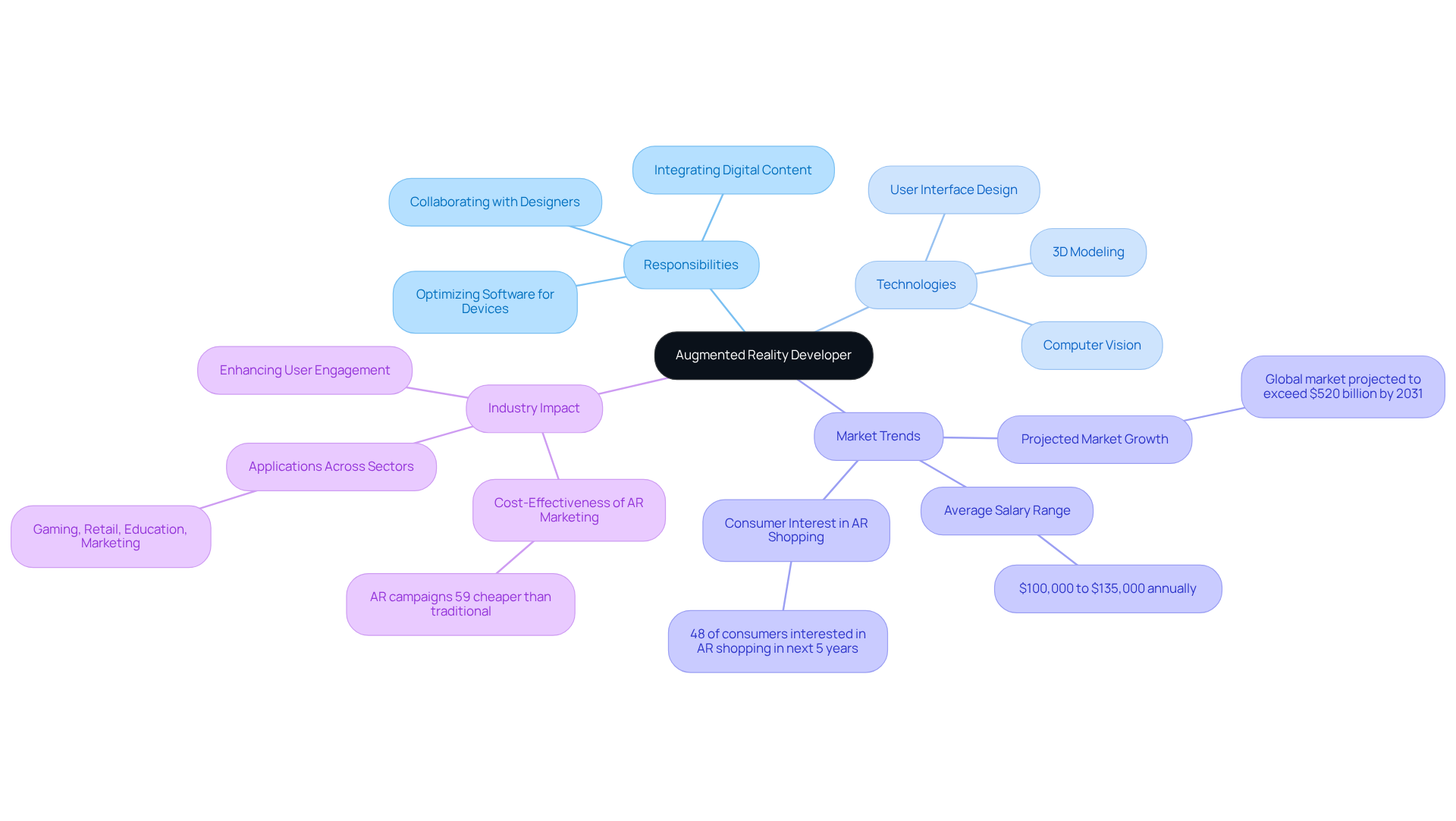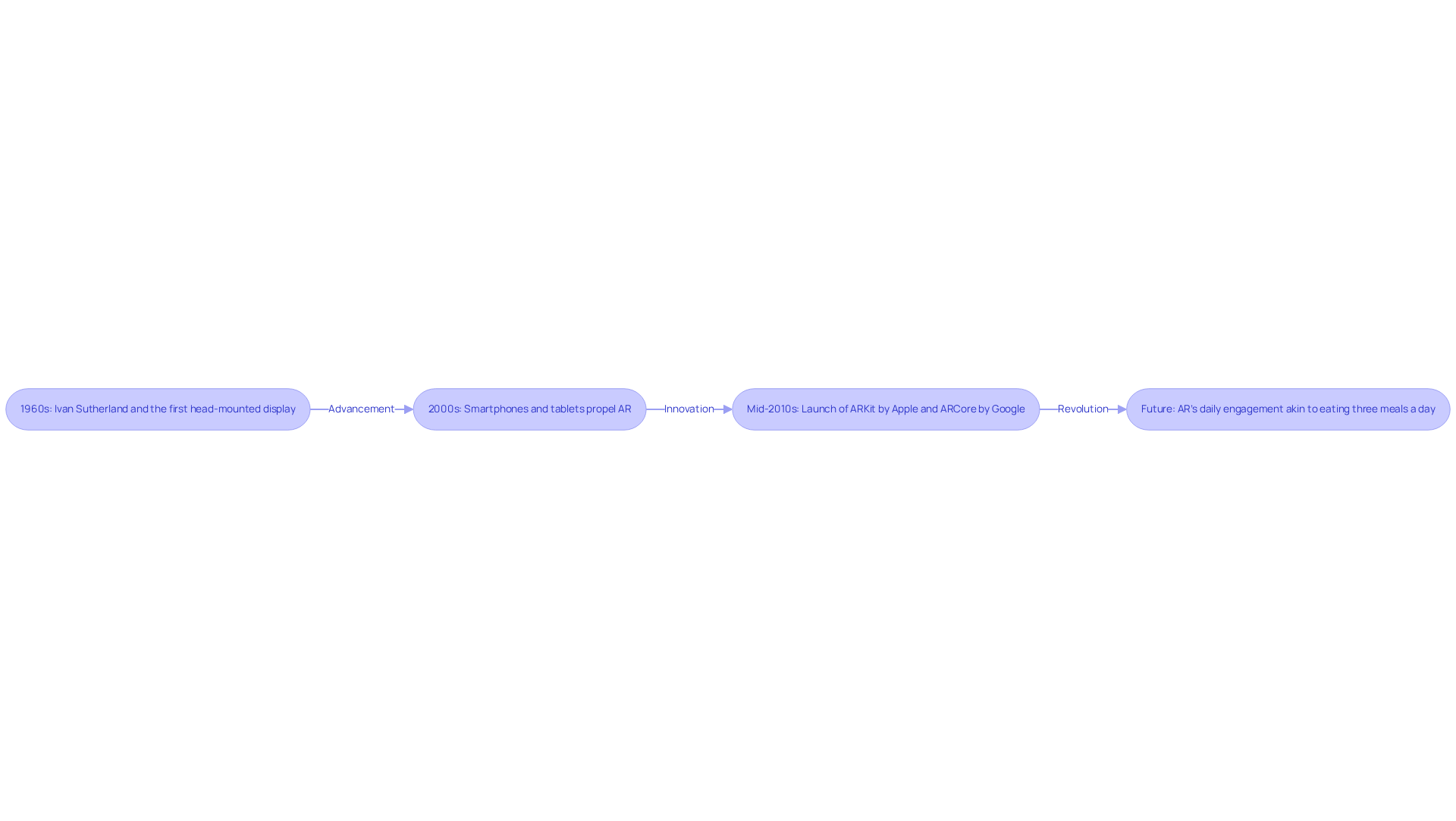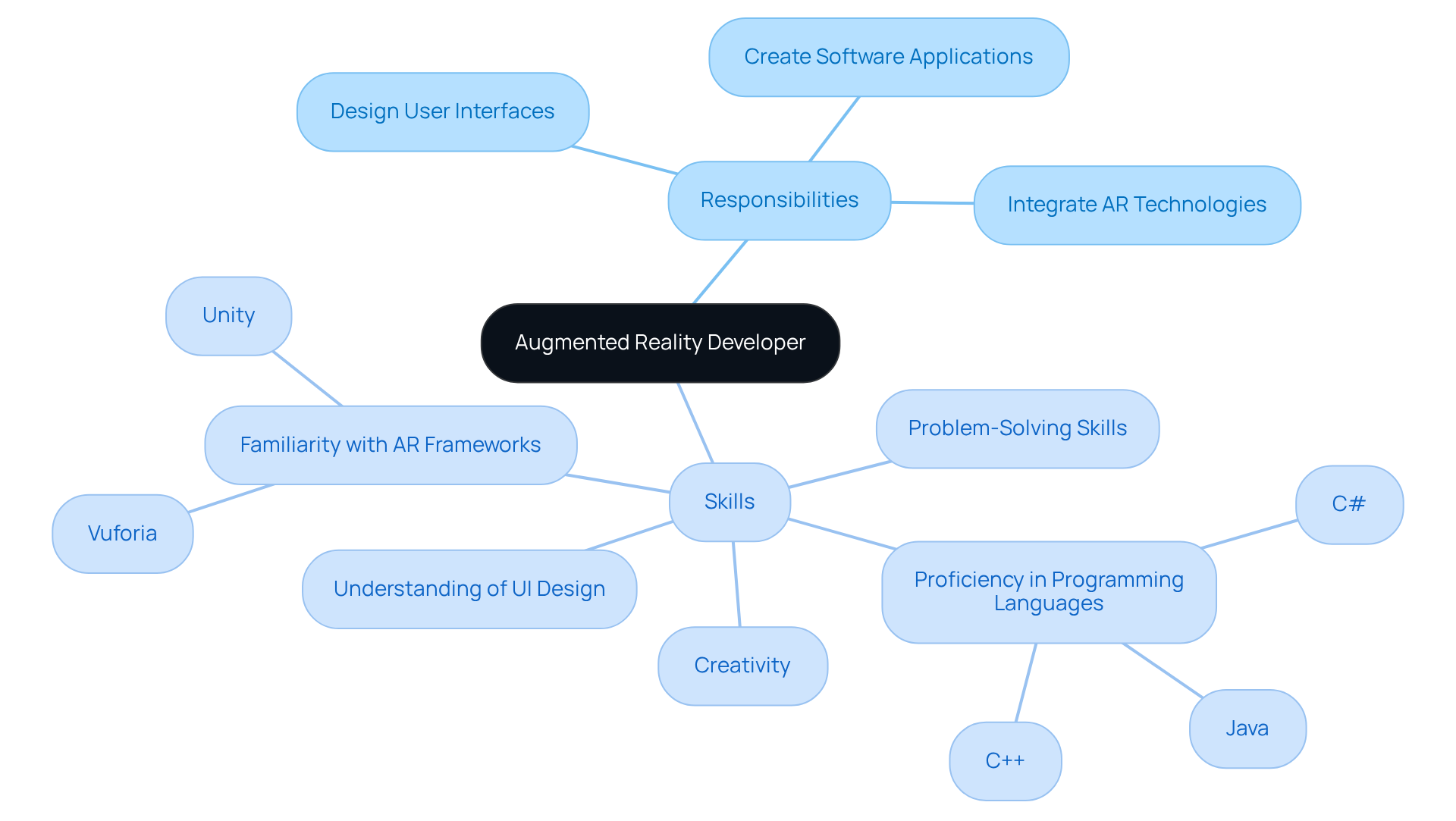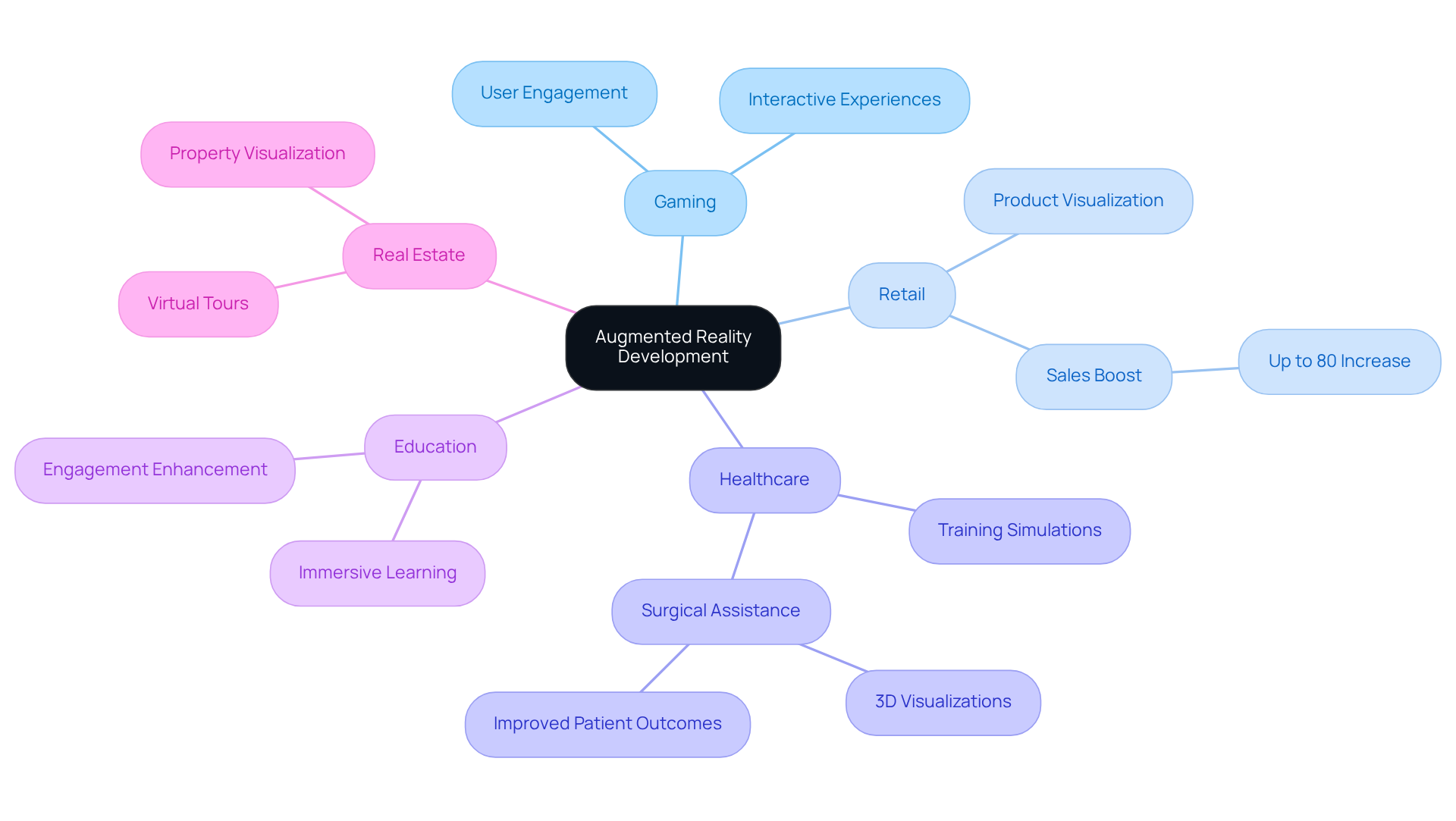Overview
The role of an augmented reality developer is pivotal in today's digital landscape, as these professionals create applications that seamlessly integrate digital content with the real world. By leveraging advanced technologies such as computer vision and 3D modeling, they significantly enhance user interaction across diverse sectors, including gaming, retail, and education.
Research indicates a burgeoning demand for these developers, fueled by the expansive growth of the AR market and an urgent need for innovative user engagement strategies. Their responsibilities are critical, encompassing the design of user interfaces and the optimization of software for a variety of devices.
As the industry evolves, collaboration with augmented reality developers becomes essential for organizations aiming to stay at the forefront of technological advancements.
Introduction
The emergence of augmented reality (AR) has revolutionized how individuals engage with digital content, leading to a significant demand for skilled professionals in this cutting-edge field. As businesses increasingly strive to captivate consumers through immersive experiences, augmented reality developers are essential in bridging the divide between the digital and physical realms.
However, with rapid technological advancements and shifting consumer expectations, what challenges and opportunities await these developers?
Delving into the diverse responsibilities and skills essential for this dynamic role not only underscores the critical importance of AR developers but also unveils the exciting potential that lies ahead across various industries.
Define Augmented Reality Developer
A specialized software engineer, known as an augmented reality developer, is dedicated to creating programs that seamlessly integrate digital content with the real world. This role encompasses designing, coding, and implementing AR applications that significantly enhance user interaction with their environment. Developers in this field leverage a variety of technologies, including computer vision, 3D modeling, and user interface design, to create software accessible via smartphones, tablets, or AR glasses. Their contributions are vital across diverse sectors, including gaming, retail, education, and marketing, where engaging user interactions are essential for success.
By 2025, the demand for augmented reality developers is expected to surge, driven by the increasing integration of AR into everyday applications. Industry leaders underscore the importance of augmented reality developers in shaping immersive experiences that captivate users and foster business growth. With the global market for AR projected to exceed $520 billion by 2031, the number of experts in this domain is anticipated to rise significantly, reflecting the expanding opportunities and responsibilities associated with augmented development.
Key responsibilities of an augmented reality developer include:
- Collaborating with designers to develop intuitive user interfaces
- Optimizing software for various devices
- Ensuring the seamless integration of digital content into real-world settings
As technology advances, programmers must also remain informed about developments in AI and machine learning, which are enhancing the capabilities of AR applications.
Magic Playbox exemplifies how augmented technology creators can craft immersive experiences that resonate with users. The company is at the forefront of innovative AR solutions that boost brand engagement and customer loyalty, setting a high standard for success in the competitive landscape. Industry experts highlight that the role of augmented reality developers will be crucial in the coming years, as businesses increasingly seek innovative strategies to engage customers. Notably, AR-enhanced marketing campaigns have been shown to be 59% cheaper on average than traditional campaigns, emphasizing the cost-effectiveness of AR applications. Furthermore, the average salary for AR/VR professionals ranges from $100,000 to $135,000 annually, indicating robust economic opportunities in this field. Nevertheless, creators must also consider potential health concerns associated with prolonged use of AR and VR technologies, alongside the rising consumer interest in AR shopping, with 48% of shoppers expressing enthusiasm for augmented experiences in the next five years.

Trace the Evolution of Augmented Reality Development
The evolution of augmented reality development is rooted in the 1960s, marked by the pioneering work of Ivan Sutherland as an augmented reality developer, whose head-mounted display laid the groundwork for future innovations. The advent of smartphones and tablets in the 2000s propelled AR into mainstream use, transforming how consumers interact with technology. The launch of ARKit by Apple and ARCore by Google in the mid-2010s revolutionized the landscape, equipping developers with powerful tools to create engaging AR applications with unparalleled simplicity. This shift has led to a remarkable surge in AR applications across diverse platforms, showcasing the work of augmented reality developers, from captivating social media filters to sophisticated e-commerce solutions.
Companies such as Magic Playbox are at the forefront of this evolution, pioneering immersive AR interactions that enhance brand engagement and foster customer loyalty. Tim Cook's forecast suggests that a significant portion of the population will engage with AR daily, akin to the routine of eating three meals a day, further solidifying its role in everyday life. Moreover, AR is transforming the retail industry by seamlessly connecting digital and physical shopping experiences, underscoring its growing significance in digital interactions.
The trajectory of AR adoption mirrors that of mobile apps, indicating its impending ubiquity akin to smartphones. This fundamental transformation will reshape how consumers engage with brands and products, presenting a compelling opportunity for brand managers to explore innovative AR solutions that resonate with their audience.

Outline Responsibilities and Skills of Augmented Reality Developers
The role of an augmented reality developer is pivotal in the XR development landscape, as they are responsible for a diverse array of tasks including:
- The design of user interfaces
- The creation of software applications
- The integration of AR technologies into existing platforms
For an augmented reality developer, proficiency in programming languages such as C#, C++, or Java is essential, complemented by familiarity with AR development frameworks like Unity or Vuforia. Furthermore, for an augmented reality developer, robust problem-solving skills, creativity, and a solid understanding of user interface design are critical for success in this field.
Augmented reality developers must remain vigilant, staying abreast of the latest AR trends and technologies to craft innovative solutions that effectively address user needs.

Explore Industries and Applications for Augmented Reality Developers
A wealth of opportunities is being discovered by augmented reality developers across a diverse array of industries, including:
- gaming
- retail
- healthcare
- education
- real estate
In the gaming sector, AR dramatically enhances user engagement through interactive experiences, as evidenced by the global phenomenon of Pokémon GO. In retail, AR tools empower customers to visualize products in their own environments before making a purchase, leading to a more informed and enjoyable shopping experience. Research indicates that integrating AR can boost sales by up to 80%, underscoring its effectiveness in driving consumer behavior.
In healthcare, AR is transforming both training and surgical procedures. It allows medical professionals to engage in training simulations that refine their skills and bolster their confidence, while also assisting surgeons by providing 3D visualizations of patient anatomy during operations. This technology not only enhances surgical precision but also contributes to improved patient outcomes. Furthermore, AR is advancing education by delivering immersive learning experiences that captivate students and foster deeper engagement.
The versatility of AR technology continues to expand, unlocking new applications and opportunities for an augmented reality developer. As industry leaders anticipate, AR is set to become as integral to daily life as mobile apps, fundamentally reshaping how we interact with our surroundings.

Conclusion
The role of an augmented reality developer is increasingly vital in today's tech landscape, as these professionals bridge the gap between digital content and the physical world. By harnessing advanced technologies, they create immersive applications that enhance user experiences across various sectors, from gaming and retail to healthcare and education. As the demand for AR continues to grow, the significance of skilled developers in this field cannot be overstated.
Key insights from the discussion reveal the diverse responsibilities of augmented reality developers, including:
- Designing user interfaces
- Optimizing software for multiple devices
- Integrating AR technologies into existing platforms
The historical evolution of AR highlights its rapid transformation from niche applications to mainstream usage, driven largely by advancements in mobile technology and the introduction of powerful development tools. Furthermore, the economic potential is evident, with AR applications proving to be both cost-effective and capable of driving substantial consumer engagement.
Reflecting on the future, the integration of augmented reality into everyday life presents an exciting opportunity for developers and businesses alike. As industries increasingly recognize the value of AR in enhancing customer interactions and improving operational efficiencies, there is a clear call for innovation and adaptation. Embracing this technology not only positions businesses at the forefront of digital transformation but also fosters a deeper connection with consumers, ultimately reshaping how they engage with brands and products.
Frequently Asked Questions
What is an augmented reality developer?
An augmented reality developer is a specialized software engineer focused on creating programs that integrate digital content with the real world, enhancing user interaction with their environment through AR applications.
What technologies do augmented reality developers use?
They utilize a variety of technologies including computer vision, 3D modeling, and user interface design to develop software accessible via smartphones, tablets, or AR glasses.
In which sectors are augmented reality developers essential?
They are vital across diverse sectors such as gaming, retail, education, and marketing, where engaging user interactions are crucial for success.
What is the projected demand for augmented reality developers by 2025?
The demand for augmented reality developers is expected to surge by 2025 due to the increasing integration of AR into everyday applications.
What are the key responsibilities of an augmented reality developer?
Key responsibilities include collaborating with designers to develop intuitive user interfaces, optimizing software for various devices, and ensuring the seamless integration of digital content into real-world settings.
How will advancements in technology impact augmented reality developers?
Developers must stay informed about advancements in AI and machine learning, as these technologies are enhancing the capabilities of AR applications.
What is the significance of companies like Magic Playbox in the AR industry?
Magic Playbox exemplifies how augmented technology creators can craft immersive experiences that enhance brand engagement and customer loyalty, setting a high standard in the competitive landscape.
How cost-effective are AR-enhanced marketing campaigns compared to traditional campaigns?
AR-enhanced marketing campaigns are shown to be 59% cheaper on average than traditional campaigns, highlighting the cost-effectiveness of AR applications.
What is the average salary for AR/VR professionals?
The average salary for AR/VR professionals ranges from $100,000 to $135,000 annually, indicating strong economic opportunities in this field.
What health concerns should creators consider regarding AR and VR technologies?
Creators must consider potential health concerns associated with prolonged use of AR and VR technologies as they develop applications.
What is the consumer interest in AR shopping?
There is a rising consumer interest in AR shopping, with 48% of shoppers expressing enthusiasm for augmented experiences in the next five years.




